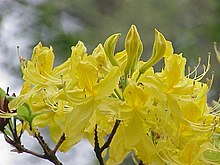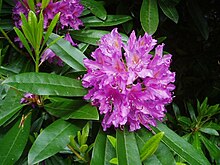Rhododendron (from Ancient Greek ῥόδον rhódon "rose" and δένδρον déndron "tree") is a genus of over 1000 species of woody plants in the heath family, most with showy flowers. It includes the plants known to gardeners as azaleas.
Description
Rhododendron is a genus characterized by shrubs and small to (rarely) large trees, the smallest species growing to 10–100 centimetres (3.9–39 in) tall, and the largest, R. giganteum, reported to over 30 metres (98 ft) tall. The leaves are spirally arranged; leaf size can range from 1–2 cm (0.39–0.79 in) to over 50 cm (20 in), exceptionally 100 cm (39 in) in R. sinogrande. They may be either evergreen or deciduous. In some species the underside of the leaves is covered with scales (lepidote) or hairs (indumentum). Some of the best known species are noted for their many clusters of large flowers. There are alpine species with small flowers and small leaves, and tropical species such as section Vireya that often grow as epiphytes. Species in this genus may be part of the heath complex in oak-heath forests in eastern North America.
Cultivation
 Both species and hybrid rhododendrons (including azaleas) are used extensively as ornamental plants in landscaping in many parts of the world, and many species and cultivars are grown commercially for the nursery trade. Rhododendrons are often valued in landscaping for their structure, size, flowers, and the fact that many of them are evergreen. Azaleas are frequently used around foundations and occasionally as hedges, and many larger-leafed rhododendrons lend themselves well to more informal plantings and woodland gardens, or as specimen plants. In some areas, larger rhododendrons can be pruned to encourage more tree-like form, with some species such as R. arboreum and R. falconeri eventually growing to 10–15 m or more tall.
Both species and hybrid rhododendrons (including azaleas) are used extensively as ornamental plants in landscaping in many parts of the world, and many species and cultivars are grown commercially for the nursery trade. Rhododendrons are often valued in landscaping for their structure, size, flowers, and the fact that many of them are evergreen. Azaleas are frequently used around foundations and occasionally as hedges, and many larger-leafed rhododendrons lend themselves well to more informal plantings and woodland gardens, or as specimen plants. In some areas, larger rhododendrons can be pruned to encourage more tree-like form, with some species such as R. arboreum and R. falconeri eventually growing to 10–15 m or more tall.Commercial growing
 Rhododendrons are grown commercially in many areas for sale, and are occasionally collected in the wild, a practice now rare in most areas. Larger commercial growers often ship long distances; in the United States most of them are located on the west coast (Oregon, Washington and California). Large-scale commercial growing often selects for different characteristics that hobbyist growers might want, such as resistance to root rot when over-watered, ability to be forced into budding early, ease of rooting or other propagation, and sale ability. In the Indian state of Himachal Pradesh, Rhododendron flowers, have been used for some time to make popular fruit and flower wines. The industry is promoted by the state government with tax benefits, looking to promote this industry as a full fledged sub class of its economy.
Rhododendrons are grown commercially in many areas for sale, and are occasionally collected in the wild, a practice now rare in most areas. Larger commercial growers often ship long distances; in the United States most of them are located on the west coast (Oregon, Washington and California). Large-scale commercial growing often selects for different characteristics that hobbyist growers might want, such as resistance to root rot when over-watered, ability to be forced into budding early, ease of rooting or other propagation, and sale ability. In the Indian state of Himachal Pradesh, Rhododendron flowers, have been used for some time to make popular fruit and flower wines. The industry is promoted by the state government with tax benefits, looking to promote this industry as a full fledged sub class of its economy.Culture & Symbolism
 Rhododendron ponticum is the state flower of Indian-administered Kashmir and Pakistan Controlled Kashmir. Rhododendron arboreum (Lali Guransh) is the national flower of Nepal. Rhododendron niveum is the state tree of Sikkim in India. Rhododendron is also the state tree of the state of Uttarakhand, India.
Rhododendron ponticum is the state flower of Indian-administered Kashmir and Pakistan Controlled Kashmir. Rhododendron arboreum (Lali Guransh) is the national flower of Nepal. Rhododendron niveum is the state tree of Sikkim in India. Rhododendron is also the state tree of the state of Uttarakhand, India.Rhododendron catawbiense, the most widespread rhododendron of the Appalachian Mountains, is the state flower of West Virginia, and is in the Flag of West Virginia. Rhododendron macrophyllum, a widespread rhododendron of the Pacific Northwest, is the state flower of Washington.
Literature
 In Joyce's Ulysses, rhododendrons play an important role in Leopold and Molly's early courtship: Molly remembers them in her soliloquy - "the sun shines for you he said the day we were lying among the rhododendrons on Howth head in the grey tweed suit and his straw hat the day I got him to propose to me".
In Joyce's Ulysses, rhododendrons play an important role in Leopold and Molly's early courtship: Molly remembers them in her soliloquy - "the sun shines for you he said the day we were lying among the rhododendrons on Howth head in the grey tweed suit and his straw hat the day I got him to propose to me".











0 comments:
Post a Comment